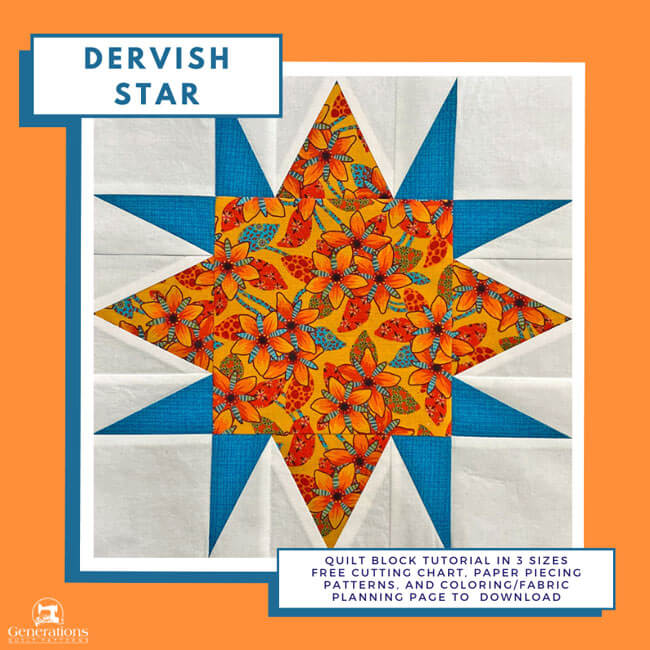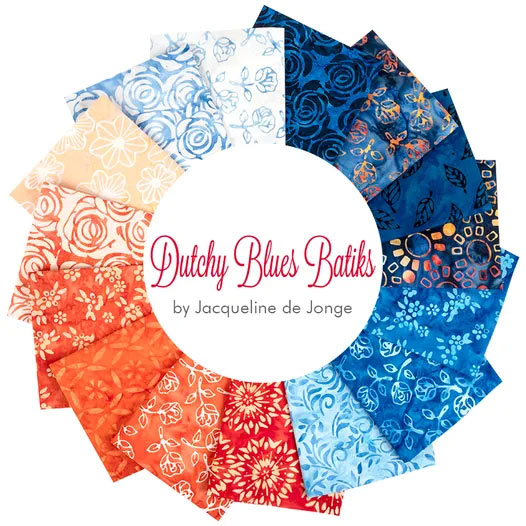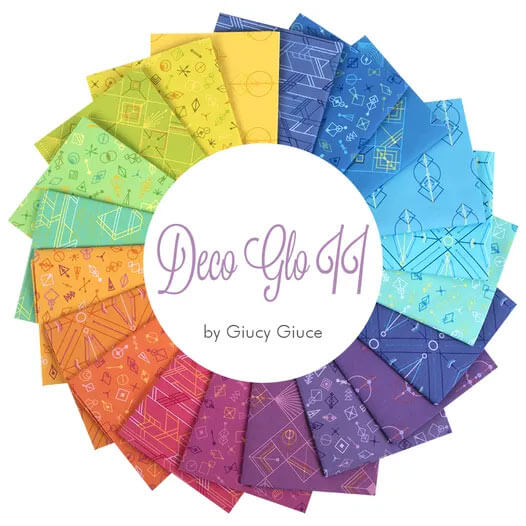- Home
- Free Quilt Block Patterns
- Dervish Star Quilt Block
Dervish Star Quilt Block Tutorial: 8", 12", and 16" finished blocks
From our Free Quilt Block Patterns Library
This post contains affiliate links, for which I receive compensation.
Are you ready to add some unique and impressive flair to your project?
The Dervish Star quilt block does just that!
Named after the mystical whirling dervish dance of Turkey, this show-stopping block showcases intricate design elements. Half Rectangle Triangles and Triangle in a Square units come together easily with paper piecing to form a mesmerizing and dynamic spinning star.
Start exploring the alluring world of Dervish Star quilt blocks today!
With our step-by-step instructions and helpful tips, you'll be stitching up these dancing stars in no time.
As always, step-by-step, beginner-friendly, illustrated instructions are the backbone of the tutorial. There's more free goodies available for you to download to help you. They are:
- What happens when you set this block on point...it'll really blow your skirt up
- Quilting not at the top of your list for now? Pin or bookmark this block for later.
It's time to cut up and sew!
General Instructions
Several abbreviations are used on this page. They are:
- SA - seam allowance
- RST - right sides together
- HRT - half rectangle triangles
- TiaS - triangle in a square
1/4" SA are used through this tutorial.
Highlighted in yellow, pressing instructions are easy to spot.
To press, first press the patches in the closed position as they came off your sewing machine. This sets the seam, melding the fibers of the threads into the fibers of the fabric.
Then press the SA to the dark unless otherwise noted.
Download and print paper piecing patterns
To download the pattern, use the most current version of Adobe.
For accurate results, on Adobe's Print Menu page, under 'Page Size and Handling' set 'Custom Scale' to 100%. Then print.
Click here to see what it looks like on the Print Menu page.
Choose your finished block size from the chart below. Print the corresponding number of pages for a total of 4 of all three different units.
Print the Patterns | |||||
|---|---|---|---|---|---|
| Finished Block Size | HRTs | Tias | |||
| Copies to print | HRT Size | Copies to print | TiaS Size | Templates | |
| 8" | 1 | 1" x 2" | 1 | 2" | Print 1 |
| 12" | 2 | 1½" x 3" | 1 | 3" | |
| 16" | 3 | 2" x 4" | 2 | 4" | |
After printing, use the 1" square graphic on the printed page(s) to double check that your patterns printed at the correct size.

Not sure which paper to use?
Take a look at my review of several of the most popular brands available to us quilters on the market.
You want a super-easy paper to tear away—less stress on the stitches.
The newest quilt fabrics to tickle your fancy...
Click the images below to see the full collection. We share any commercial and/or free patterns that showcase them, too. (For inspiration, of course!)
Step 1: Cutting patches for your Dervish Star
 Dervish Star quilt block design
Dervish Star quilt block designSample Block Size: 12" finished / 12½" unfinished
Grid: 8x8
Design Type: Uneven 9-patch | Star
As you consider your fabric choices, perhaps this block is just the right place for that spectacular, bold, all-over print you've been saving?
Please label all your patches. We use their numbers throughout this tutorial.
To print a copy of the block design and cutting chart to use at your cutting table, click here.
 | Cutting Chart for a~ Paper PLUS Traditional Piecing ~ | ||||
|---|---|---|---|---|---|
| Patch | Fabric | Qty | Finished Block Size | ||
| 8'' | 12'' | 16'' | |||
| 1, Side, Side.R | Bac | 8 | 2⅞'' x 3¼'' | 3⅜'' x 4¼'' | 3⅞'' x 5¼'' |
| 2 | Dark | 4 | 2⅞'' x 3¼'' | 3⅜'' x 4¼'' | 2⅞'' x 5¼'' |
| 3 | Bac | 4 | 2½'' x 2½'' | 3½'' x 3½'' | 4½'' x 4½'' |
| 4 | Medium | 1 | 4½'' x 4½'' | 6½'' x 6½'' | 8½'' x 8½'' |
| Center | Medium | 4 | 3" x 2¾'' | 4" x 3¾'' | 5" x 4¾'' |
| Unfinished Block Size | 8½'' | 12½'' | 16½'' | ||
| Grid Size | 1'' | 1½'' | 2'' | ||
Subcutting patches
We need mirror image patches for both the HRTs and TiaS units.
Layer your background #1 and Side patches RST. Layer your dark #2 patches RST. This is what creates the mirror image patches when you cut.
With both groups of patches oriented with the short edges on the top and bottom, make a mark at the edge, 5/8" in from the top left and 5/8" in from the bottom right.
Line up your ruler with these marks at the top and bottom edges and cut in half with your rotary cutter.
Below, the stack of #2 patches has been cut in half.

For the TiaS, the patches can be right side up or down—it doesn't matter. Lay the Center template on top of the four rectangles. The top and bottom edges of the template should match the edges of your Centers.
Use your rotary cutter to remove the excess from both sides.
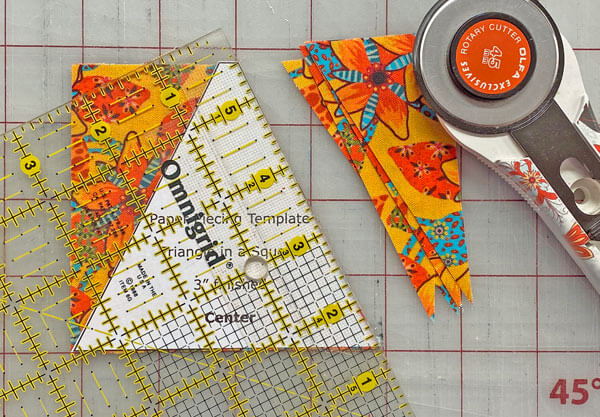 After cutting the first side
After cutting the first sideStep 2: Assemble the patches for a Dervish Star
All the sewn units in this block are paper pieced for speed and accuracy. The first thing to do is set up our sewing machine.
General Sewing Machine Setup for Paperpiecing
- Reduce your stitch length to 16–20 stitches per inch (1.3-1.6 mm). This perforates the paper and stabilizes the seam when you remove the pattern. [Learn more about stitch length here.]
- Reduce your machine's speed or just plain slow down. Sew only as fast as you can stay on the stitching lines.
- Install an open toe appliqué foot (sometimes called an 'embroidery' or 'satin stitch' foot) if you have one (it's easier to see where you're stitching with one installed).
- Use a larger needle (90/14) if you have problems removing the pattern.
- If your machine has a needle stop up, use it. The stitching goes faster when you don't have to lift the presser foot with every seam.
- As you stitch each seam, start and stop a generous 1/4” before and after the solid stitching lines. ALWAYS. Future lines of stitching secure the ends.
After adding each patch, press the unit as it was sewn to set the seam and then open. The SA is automatically pressed towards the last patch added.
Before adding the next patch, take a look to make sure the one you just added covers the space plus seam allowance that it is supposed to.
Steam is optional and usually curls the pattern.
If that bothers you, don't use steam. Sometimes I do. Sometimes I don't.
It truly depends on my mood.
Remember, as you follow this paper piecing tutorial, the printed and the fabric sides of this block are mirror-images of each other.
At last!
Let's sew!
Triangle in a Square Unit (TiaS)
Make 4

Use just a wee bit of Elmer's Washable Glue Stick to hold the backside of the Center patch in place on the unprinted side of the TiaS pattern.
The dashed guidelines make this quick and easy to do accurately.
 The red arrows point to the patch that's glued to the unprinted side of the pattern
The red arrows point to the patch that's glued to the unprinted side of the patternWith RST align the long bias edge of a Side with the Center. If your background is light like mine, nudge the Side a couple of threads past the edge of the Center.
This will prevent the darker fabric from shadowing through the lighter one.
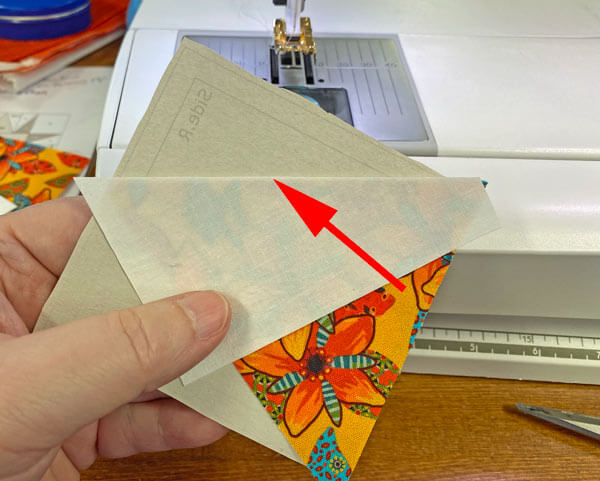
Sew on the solid line starting and ending past the outside edge of the TiaS as shown below.
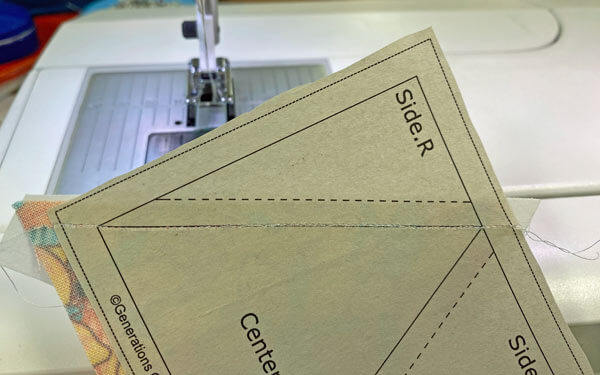 The stitches should extend past the beginning and end of the seam, past the outside edges of the unit
The stitches should extend past the beginning and end of the seam, past the outside edges of the unitPress.
Add the second Side just as you did the first one.

Press.
Here is an untrimmed versus a trimmed unit.
 Untrimmed (left) and trimmed to the perfect size (right)
Untrimmed (left) and trimmed to the perfect size (right)To trim, line up the 1/4" line on your ruler (red arrow) with one side of the solid square.
Cut away the excess with your rotary cutter. (I find it so much easier to match the 1/4" with the solid line than the edge of my ruler with the outside dashes.)
 Trimming the first side of a sewn TiaS—3 more to go!
Trimming the first side of a sewn TiaS—3 more to go!After trimming is complete, we've got four accurate TiaSs with all the points and angles exactly where they need to be.

Half Rectangle Triangle (HRT) Units
Make 4 ea, A and B units
 These images are shown from the fabric side.
These images are shown from the fabric side.When you look at the printed pattern as compared to the illustration above, you'll notice they are the mirror image of each other. We've taken this into account as we cut our patches. (Remember we subcut those rectangles in pairs right sides together.)
Use the Elmer's Glue Stick (with a light touch) to stick the backside of the correct #1 patch to the unprinted side of the patterns. Use that dashed line for quick placement.
 You can just make out the shadow of the patch, properly positioned on the unprinted side of this pattern
You can just make out the shadow of the patch, properly positioned on the unprinted side of this patternWith RST, align the long bias edge of a #2 with #1.
If you are new to making HRTs, fold back the patch before stitching to check that you've used the correct patch. For HRTs it's always narrow edge to wide one.

The seam runs from clear across the unit. That means we can chain piece all eight HRTs to save a bit of time.
Trim these HRTs to size the same way we did the TiaS.
Below are the pairs of 'Bs' (left) and 'As' (right), untrimmed versus trimmed.
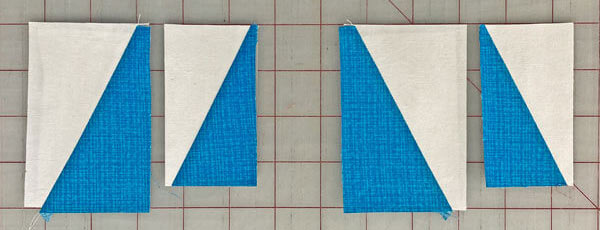 Untrimmed versus trimmed units, B on the left and A on the right...chalk it up to not enough caffeine when I took the picture!
Untrimmed versus trimmed units, B on the left and A on the right...chalk it up to not enough caffeine when I took the picture!
The paper piecing is complete. From this point forward, return your stitch length to the one you regularly use for piecing and install your favorite 1/4" presser foot.
At this point, I remove all the paper, it's so much easier to stitch units together without it.
A lot less lumpy, too.
Remember, by precutting and then carefully subcutting our patches, all the outside edges of our TiaSs and HRTs are on the stable straight of grain. There is no bias to stretch out of shape.
The paper no longer serves a purpose. Get rid of it! :D
Sides
Make 4
If we've done a good job stitching directly on the line (especially where the it hits an outisde edge), these units will practically sew themselves together.
That is the beauty of paper piecing. The stitching is mindless, the trimming straightforward, and the results are accurate.
 A Side constructed from a HRT-A, an HRT-B, and a TiaS
A Side constructed from a HRT-A, an HRT-B, and a TiaSWith RST, sew an 'A' HRT to the left side of and TiaS and a 'B' HRT to the right.
Pin to hold all the edges together.
If your stitching wasn't quite up to your usual accuracy, have a look at this article on Pinning for Perfect Points.

These seams are pressed away from the TiaS.
They can be a bit lumpy. To smush ( quite the technical quilting term, eh? :D ) the lumpiness, use my 'secret pressing technique'. Simple to do.
Unbelievable results.
Step 3: Assemble your Dervish Star quilt block
Arrange the stitched and cut patches into the Dervish Star design. Cut #3 squares in the four corners. A big luscious hunk of a yummy print in the center and the background side of the 'Sides' towards the outside edge.

With RST, sew the units in each row together.
SAs are pressed away from the Side units in each row.

Stitch the last two seams to complete your Dervish Star quilt block.
The seams at the corners nest. Use pins to keep them together as you sew and keep those edges even.
My favorite 1/4" foot has a flange on the right-hand side. As long as your pins don't hang over the edge, they don't get in the way while sewing.
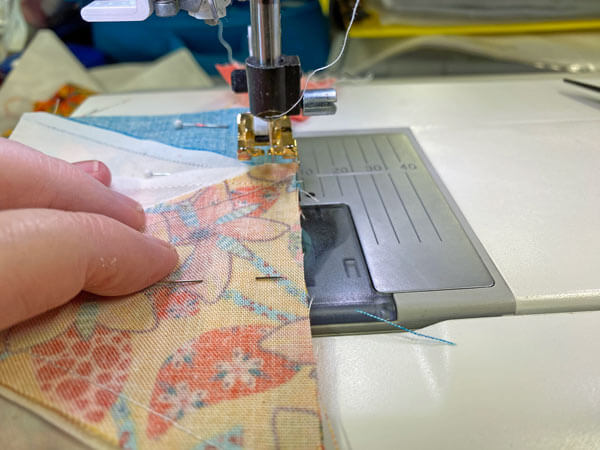
And here's our finished Dervish Star quilt block. Paper piecing makes all those pointy points easy to piece. Add them to a standout print, and you've got a smashing quilt block.

Here's a quick peek at the back.

What happens when a Dervish Star is set on point?
Any time you see half rectangle triangles used as star points, you just KNOW that there's something good in store for you when the block is set on point.
Our Dervish Star quilt block doesn't disappoint.

🔭 Looking for something truly stellar?
You've finished your star quilt block, and you're ready for more!
Browse our collection of 70 stellar star quilt block patterns. All have instructions and cutting charts in multiple sizes. If templates or paper piecing is used in the tutorial, there's a free download for you of those materials.
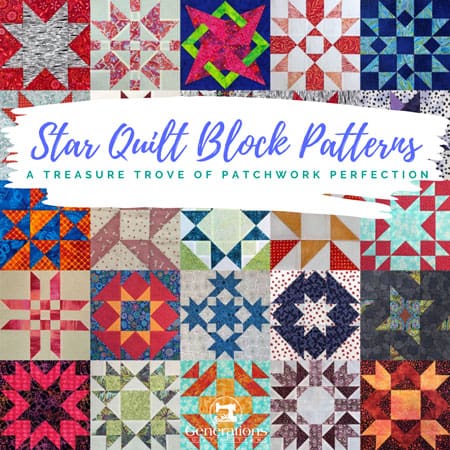
Eeny. Meenie. Miney. Moe.
Which star quilt block will you sew?
For a star-studded quilting experience, choose from 100+ bedazzling star quilt patterns—for beginners and beyond—click here.
For even MORE blocks to make… 🧩🎨

...visit our Free Quilt Block Pattern Library, with over 260+ blocks to choose from in multiple sizes.
Free downloads are included in all sizes for any blocks require paper piecing patterns or templates.
- Home
- Free Quilt Block Patterns
- Dervish Star Quilt Block
